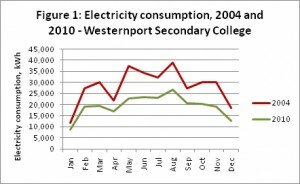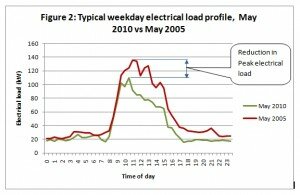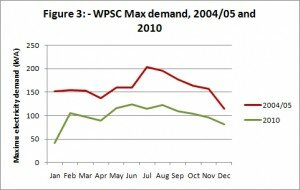Last week I attended the All Energy conference in Melbourne. Running over 2 days, with over 30 conference sessions, just one was dedicated to energy efficiency. Rob Murray Leach, head of the Energy Efficiency Council who chaired the session, kicked it off by saying that this was the most important session of the conference, as 65% of the world’s carbon reduction by 2020 to come from energy efficiency according to the International Energy Agency.
But is energy efficiency getting 65% of the press coverage, is it 65% of the conversation around 2020 carbon abatement targets? Clearly it isn’t.
There is a massive vacuum when it comes to awareness and understanding of the most cost effective way by far of reducing carbon emissions – energy efficiency. Have a conversation about reducing your carbon footprint, and the first thing to come up will be solar panels, not building controls.
Yet from an economic perspective energy efficiency is extraordinarily interesting in comparison with solar. At commercial electricity tariffs, without subsidies, even the cheapest solar PV system has a payback of over 25 years.
Cover the entire roof of a typical two or three storey office building with solar panels and you’ll reduce electricity usage at the site by around 15%, whilst spending about four times your annual electricity costs to buy the solar system. Yet energy efficiency could probably deliver that same 15% saving with a 2 to 3 year return on investment.
So why isn’t energy efficiency getting the attention it deserves?
As an industry we haven’t been effective in promoting energy efficiency. The recently formed Energy Efficiency Council, of which CarbonetiX is a member, is now taking up this challenge, but there is a long way to go.
Energy efficiency is not visible. The results of changes to the lights and the way the air conditioning is controlled are only visible to the person paying the much lower energy bills, and the person who championed the changes. Solar panels are visible to everyone.
The invisibility of energy efficiency is compounded by the fact that the good news stories aren’t told. They may not even be told to people in the building where the savings have been achieved, let alone to the wider public.
And energy efficiency, whilst it gets good savings, is not that easy to do, but there is a perception that it is easy. So organisations may undertake a DIY approach, with no training and no experience, and not achieve any noticeable savings. A classic DIY approach would be to spend $2,000 to get occupancy sensors fitted to control the lights in the toilets – I’m sorry but the savings from this simply won’t show up in your energy bills.
The problem arising from failed DIY efforts is that this then creates the perception that energy efficiency doesn’t work. And nothing could be further from the truth. Yes, energy efficiency does work, but you need to know what you are doing. Businesses don’t get the receptionist to do their tax return. A qualified, experienced accountant who is normally contracted to do so. But when it comes to saving energy, all too often its assumed that an environmental officer or a facility maintenance officer can effectively do energy efficiency.
So, to raise the profile of energy efficiency, celebrate and promote the savings you achieve. Put up a plaque above reception showing how much you have saved, or a graph of how your energy use has gone down. Get a high NABERS rating and put the certificate in reception as well. Talk about what was done to use the savings. Get a case study done and circulate it amongst your staff. Then send the case study off to your local paper and get them to do a profile on what you have achieved.
And to get those savings, to make energy efficiency really work for you, get expert advice and guidance.






